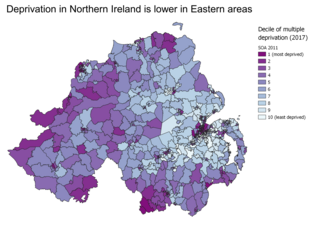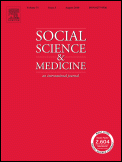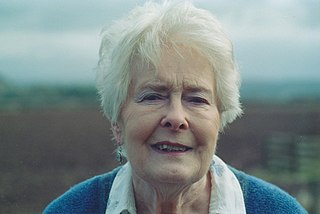Related Research Articles
A census tract, census area, census district or meshblock is a geographic region defined for the purpose of taking a census. Sometimes these coincide with the limits of cities, towns or other administrative areas and several tracts commonly exist within a county. In unincorporated areas of the United States these are often arbitrary, except for coinciding with political lines.

The Medical Research Council (MRC) is responsible for co-coordinating and funding medical research in the United Kingdom. It is part of United Kingdom Research and Innovation (UKRI), which came into operation 1 April 2018, and brings together the UK's seven research councils, Innovate UK and Research England. UK Research and Innovation is answerable to, although politically independent from, the Department for Business, Energy and Industrial Strategy.
ONS codes are geocodes maintained by the United Kingdom's Office for National Statistics to represent a wide range of geographical areas of the UK, for use in tabulating census and other statistical data. These codes are also known as GSS codes, referring to the Government Statistical Service of which ONS is part.
Geodemography is the study of people based on where they live.; it links the sciences of demography, the study of human population dynamics, and geography, the study of the locational and spatial variation of both physical and human phenomena on Earth, along with sociology. It includes the application of geodemographic classifications for business, social research and public policy but has a parallel history in academic research seeking to understand the processes by which settlements evolve and neighborhoods are formed. Geodemographic systems estimate the most probable characteristics of people based on the pooled profile of all people living in a small area near a particular address.
Glasgow is a city located on the banks of the River Clyde, in West Central Scotland.

The State Hospital is a psychiatric hospital in the village of Carstairs, in South Lanarkshire, Scotland. It provides care and treatment in conditions of high security for patients from Scotland and Northern Ireland. The hospital is managed by the State Hospitals Board for Scotland which is a public body accountable to the First Minister of Scotland through the Scottish Government Health and Social Care Directorates. It is a Special Health Board, part of the NHS Scotland and the only hospital of its kind within Scotland.
The Indices of deprivation 2004 is a deprivation index at the small area level, created by the British Department for Communities and Local Government(DCLG).
EDINA is a centre for digital expertise, based at the University of Edinburgh as a division of the Information Services Group.
The Neighbourhood Statistics Service (NeSS) was established in 2001 by the UK's Office for National Statistics (ONS) and the Neighbourhood Renewal Unit (NRU) - then part of the Office of the Deputy Prime Minister (ODPM), now Communities and Local Government (CLG) - to provide good quality small area data to support the Government's Neighbourhood Renewal agenda. This cross-Government initiative also involved the co-operation and partnership of data suppliers across departments, agencies and other organisations. The ONS closed the Neighbourhood Statistics website for England and Wales on the 12 May 2017. To offset this, the ONS is aiming to meet the needs of users via the ONS website, although direct postcode searches are no longer available to users.
Social class in New Zealand is a product of both Māori and Western social structures. Researchers have traditionally discussed New Zealand, a first-world country, as a "classless society", but this claim is problematic in a number of ways. Since at least the 1980s it has become easier to distinguish between the wealthy and the underclass in New Zealand society.

Indices of multiple deprivation (IMD) are widely-used datasets within the UK to classify the relative deprivation of small areas. Multiple components of deprivation are weighted with different strengths and compiled into a single score of deprivation.

Social Science & Medicine is a peer-reviewed academic journal covering social science research on health, including anthropology, economics, geography, psychology, social epidemiology, social policy, sociology, medicine and health care practice, policy, and organization. It was established in 1967 and is published by Elsevier.

Multidimensional Poverty Indices use a range of indicators to calculate a summary poverty figure for a given population, in which a larger figure indicates a higher level of poverty. This figure considers both the proportion of the population that is deemed poor, and the 'breadth' of poverty experienced by these 'poor' households, following the Alkire & Foster 'counting method'. The method was developed following increased criticism of monetary and consumption based poverty measures, seeking to capture the deprivations in non-monetary factors that contribute towards well-being. While there is a standard set of indicators, dimensions, cutoffs and thresholds used for a 'Global MPI', the method is flexible and there are many examples of poverty studies that modify it to best suit their environment. The methodology has been mainly, but not exclusively, applied to developing countries.
The OECD Better Life Index, created in May 2011 by the Organisation for Economic Co-operation and Development, is an initiative pioneering the development of economic indicators which better capture multiple dimensions of economic and social progress.
The New Zealand Attitudes and Values Study (NZAVS) is a longitudinal study conducted in New Zealand. The NZAVS was started in 2009 by Chris Sibley, a professor in psychology at the University of Auckland. The NZAVS was inspired by major social surveys conducted internationally, such as the National Election Studies, the World Values Survey and the General Social Survey, and aims to provide a similar resource for New Zealand. As of November 8, 2016, the NZAVS research team had published 100 peer reviewed publications using data from the study.
The Townsend index is a measure of material deprivation within a population. It was first described by sociologist Peter Townsend in 1988.

Dame Sarah Jane Macintyre, known as Sally Macintyre, is a British medical sociologist. She is a professor emerita at the University of Glasgow.
The ONS Postcode Directory (ONSPD) relates both current and terminated postcodes in the United Kingdom to a range of current statutory administrative, electoral, health and other area geographies. It also links postcodes to pre-2002 health areas, 1991 Census enumeration districts for England and Wales, 2001 Census Output Areas (OA) and Super Output Areas (SOA) for England and Wales, 2001 Census OAs and SOAs for Northern Ireland and 2001 Census OAs and Data Zones (DZ) for Scotland. It helps support the production of area based statistics from postcoded data.

Vera Dorris Lilian Carstairs was a British social scientist noted, in particular, for a groundbreaking 1991 research study, Deprivation and Health in Scotland, which related mortality, morbidity and hospital admissions in Scotland, with the social composition and living standards found in Scottish areas. She gives her name to the Carstairs index.
References
- 1 2 Carstairs, V.; Morris, R. (1991). Deprivation and Health in Scotland. Aberdeen University Press.
- ↑ Elliott P, Cuzick J, English D, Stern R. Geographical and Environmental Epidemiology. Methods for Small-Area Studies. Oxford University Press. New York, 1997
- ↑ "University of Glasgow - Research Institutes - Institute of Health & Wellbeing - Research - MRC/CSO Social and Public Health Sciences Unit - Research programmes - Measurement and Analysis of Socio-economic Inequalities in Health - Carstairs scores". April 26, 2018. Archived from the original on 2018-04-26.
- ↑ "Health stats" (PDF). www.ons.gov.uk. 2006. Retrieved 2020-09-04.
- ↑ Brown, D., Allik, M., Dundas, R. and Leyland, A. H. (2014) Carstairs Scores for Scottish Postcode Sectors, Datazones and Output Areas from the 2011 Census. Technical Report. MRC/CSO Social and Public Health Sciences Unit, University of Glasgow, Glasgow. http://eprints.gla.ac.uk/99555/
- ↑ McLoone, P. (2004) Carstairs scores for Scottish Postcode sectors from the 2001 Census. MRC/CSO Social and Public Health Sciences Unit, University of Glasgow
- ↑ McLoone, P. (1994) Carstairs Scores for Scottish Postcode Sectors from the 1991 Census. Public Health Research Unit, University of Glasgow http://www.sphsu.mrc.ac.uk/files/File/library/other%20reports/Carstairs.pdf